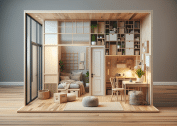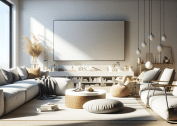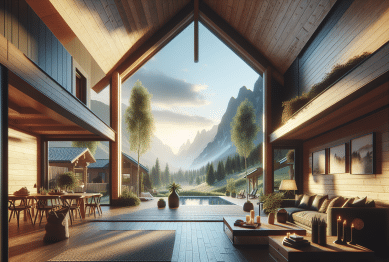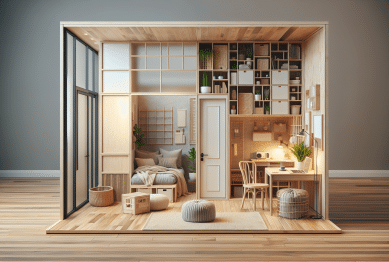Explore engaging ways to bring new life to your home. This guide reveals creative interior design ideas, budget-friendly DIY décor, and smart organization tips, all designed to help you create a living space that truly feels like your own, using accessible home styling secrets and practical lifestyle advice.
Discovering Your Personal Style in Home Decor
Finding your unique style can spark inspiration. Interior design isn’t about copying trends; it’s about creating spaces reflecting your personality. Spend time browsing home décor blogs, magazines, and virtual design tools. These resources often showcase a wide range of home styling ideas, from modern minimalist to cozy eclectic. Take note of textures, colors, or layouts that appeal to you. Creating a mood board of favorite looks can reveal patterns and preferences. It helps translate online examples and showrooms into choices that feel authentic in your own home. By being intentional, even small decorative changes—like a statement cushion or a gallery wall—can spotlight your personal taste and make any space feel special.
Identifying your go-to color palette is helpful for a cohesive vibe. Explore color theory basics, such as warm versus cool tones, or the impact of bold accents. Many design professionals recommend starting with neutrals on main pieces, then introducing splashes of color through accessories. If you gravitate toward more saturated shades, experiment carefully—throw blankets, area rugs, or removable wallpapers can all be creative ways to inject personality without long-term commitment. Remember, a unified palette can make even mixed furniture styles look intentionally curated, not mismatched.
Consider how lifestyle influences décor choices. Families with children may prioritize durability and easy-clean materials, while pet owners might seek out stain-resistant fabrics. For those who love to entertain, open layouts and flexible seating can make a living space more inviting. By understanding daily habits and routines, it becomes simpler to pick furniture and organization systems that support both function and beauty. Ultimately, style evolves alongside life, so keep experimenting—your space should feel as dynamic as your interests and needs. https://www.houzz.com/magazine/home-decor
Budget-Friendly DIY Projects to Refresh Your Space
DIY décor is accessible and fun. Many interior transformations don’t require professional experience or large investments. Start by repurposing what’s already at home: rearrange furniture, paint thrifted finds, or update cabinet hardware for an instant refresh. Simple DIY wall art, such as abstract paintings or framed fabric swatches, can add interest without costly materials. Repurposing glass jars for vases, or making cushion covers from old clothes, also helps minimize waste. These small projects can deliver a big sense of accomplishment and immediate style upgrades. Explore step-by-step guides online, which often include supply lists, safety tips, and video tutorials that walk through each process.
Seasonal makeovers offer a low-commitment way to test new looks. Switch out soft furnishings—like curtains, throws, and table linens—to create different moods. Nature-inspired décor is a growing trend, with many turning to homemade wreaths and hand-picked bouquets. For renters or those who want flexibility, removable wall decals or peel-and-stick backsplashes deliver impact with easy removal. Work with what’s available: pinecones, branches, and even mismatched mugs can be artfully displayed in creative arrangements. Remember, imperfection can be beautiful—handmade touches bring warmth and authenticity that mass-produced items can’t replicate.
Upcycling not only saves money but also supports sustainability. Try breathing new life into tired furniture by sanding and painting wood pieces, or reupholstering chairs with fresh fabric. Many communities offer creative reuse centers where you can find affordable materials and inspiration. Sharing projects with friends or joining local maker groups fosters a sense of community. Not only do these strategies stretch your décor budget further, but they also encourage a sense of pride and ownership in your refreshed home environment. https://www.habitat.org/stories/diy-home-decor-on-a-budget
Organization Tips That Make Spaces Feel Bigger
Smart organization transforms how a living area feels and functions. Decluttering is often the first step, creating more visual space and reducing stress. Use baskets, drawer organizers, and wall-mounted racks to simplify daily routines. Vertical storage—like shelves above doorways or tall bookcases—makes the most of unused areas. Multi-functional furniture with hidden compartments keeps necessities close by but out of sight. As surfaces clear, spaces instantly appear larger and more welcoming. These practical solutions work equally well in small apartments and larger homes.
Zone your home for different activities without major renovations. Rugs, open shelves, and screen dividers can define relaxation corners, office nooks, or play areas in open-concept layouts. Consider the flow of foot traffic when arranging furniture, leaving clear paths to make rooms feel open and accessible. By dedicating zones, you encourage order and help reduce mess. Organization isn’t just about storage—it’s about designing spaces that adapt to everyday needs. Digital organization also matters: nicely labeled charging stations and cable boxes keep tech clutter in check.
Hidden storage keeps essentials at hand while minimizing clutter. Ottoman benches, under-bed bins, and wall hooks all offer storage with style. Some opt for baskets slid into open shelving, which combines easy access with tidy aesthetics. Labeling containers or using clear bins makes it simple to find what you need, eliminating the hunt for misplaced items. With these smart storage ideas, even compact homes can feel surprisingly spacious. https://www.architecturaldigest.com/story/home-organization-tips
Using Light and Color for Effortless Home Makeovers
Natural light is a transformative design tool. Maximize sunlight by keeping windows unblocked and choosing sheer curtains. If daylight is limited, add mirrors to bounce light around the space. Strategic lighting—such as floor lamps in dark corners or under-cabinet LEDs in kitchens—can brighten a room instantly. Experimenting with bulbs of different warmth levels also affects how colors and furniture look. By layering light sources, spaces feel more cheerful and functional at all hours.
Color influences mood and energy. Lighter walls make rooms seem bigger, while darker tones offer cozy sophistication. Accent colors can be introduced through artwork, vases, or statement furniture. If painting feels daunting, try peel-and-stick wallpaper in small doses—for example, behind shelves or on a single wall. Even switching pillow covers seasonally is a simple way to refresh color schemes. These subtle shifts let your style evolve without major overhauls.
Plants add both vibrancy and calm. Consider easy-care varieties like snake plants or pothos for beginners. Greenery brings life to plain corners and helps purify air, supporting overall well-being. Grouping plants at different heights creates visual interest and a touch of the outdoors. As an added bonus, living walls or hanging planters make great conversation pieces. These botanical touches highlight just how easy home transformation can be. https://www.bhg.com/decorating/makeovers/fresh-home-ideas
Integrating Entertainment Areas Into Everyday Living
Home entertainment isn’t limited to TV screens. Dedicate a shelf for board games, a cozy nook for reading, or set up a playlist-stationed speaker for spontaneous dance breaks. Quick access to games, books, or music encourages relaxation and socializing. Multifunctional coffee tables that double as board game storage or built-in benches with headphones have become increasingly popular as ways to turn living rooms into fun hubs.
Flexible furniture promotes gatherings both big and small. Consider lightweight stools, poufs, or beanbags that can be easily moved as needed. Mobile carts offer space for snacks or crafts to support spontaneous activities. Keeping an open area allows space for yoga, workouts, or kids’ playdates. Versatile layouts mean you can switch up your space as lifestyles and interests change, all without buying expensive new pieces.
Creating themed zones for movie nights or craft projects adds excitement. Soft lighting—like string lights or battery-powered candles—instantly signals downtime. By organizing simple rituals or weekly gatherings, many find their homes become vibrant social centers. Anchoring entertainment areas in daily routines fosters connections and makes memories in your own living space. https://www.apartmenttherapy.com/entertainment-zone-34780762
Maximizing Comfort for Everyday Wellness
Comfort underpins every great living space. Plush rugs, soft throw blankets, and ergonomic seating contribute to a sense of everyday luxury. Don’t underestimate the power of scent—essential oil diffusers, fresh flowers, or even a tray of citrus fruits can enhance mood. Pay attention to sound, too: gentle background music or a bubbling tabletop fountain creates an atmosphere where unwinding feels natural and distraction melts away.
Establishing routines for relaxation is crucial for busy lives. Carve out time for cozy evenings—whether it’s curling up with a good book or sipping tea in a favorite chair. Encourage mindful living by designing quiet corners, such as a small reading nook or window seat. Investing in quality sleep through blackout curtains, supportive mattresses, and calming color palettes supports both physical and mental health, helping every member of the household thrive.
For shared spaces, comfort means accommodating various preferences. Layering textures and having extra throws or cushions is a universal way to make rooms more inviting. Providing flexible climate controls—like fans, heaters, or soft lighting—helps everyone feel at ease. Ultimately, a truly comfortable home is one that adapts to and celebrates the people within. https://sleepfoundation.org/sleep-hygiene/creating-bedroom-healthy-sleep
References
1. Houzz Editorial Team. (n.d.). Home Decor Articles and Advice. Retrieved from https://www.houzz.com/magazine/home-decor
2. Habitat for Humanity. (n.d.). Easy DIY Home Decor Projects on a Budget. Retrieved from https://www.habitat.org/stories/diy-home-decor-on-a-budget
3. Architectural Digest Editors. (n.d.). 15 Organization Tips for Your Home. Retrieved from https://www.architecturaldigest.com/story/home-organization-tips
4. Better Homes & Gardens. (n.d.). Fresh Home Decorating Ideas. Retrieved from https://www.bhg.com/decorating/makeovers/fresh-home-ideas
5. Apartment Therapy. (n.d.). Creating an Entertainment Zone in Small Spaces. Retrieved from https://www.apartmenttherapy.com/entertainment-zone-34780762
6. Sleep Foundation Editorial Team. (n.d.). Creating the Bedroom Environment for Good Sleep. Retrieved from https://sleepfoundation.org/sleep-hygiene/creating-bedroom-healthy-sleep









